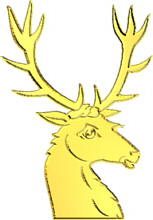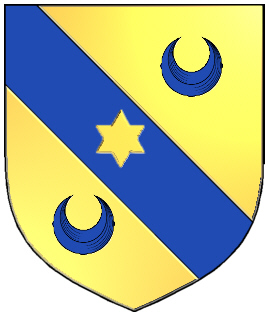Art by Betmatrho in
this Red-Thread Genealogy section for the
'Lost Tribes of Israel'
may
be freely used for personal use.
Scottish Origins
Coat of Arms: A gold shield crossed with a blue bend bearing a star between two crescents
Crest: Description not available
Motto: Amo
Motto Translated: I love

Coat of Arms: A gold shield crossed with a blue bend bearing a star between two crescents
Crest: Description not available
Motto: Amo
Motto Translated: I love

Coat of Arms:
Gold with a blue bend on which there is a star between two crescents
Crest: A stag
Motto: Amo
Motto Translated: I love
English and
Scottish Origins
Spelling variations include: Scott, Scot, Scotach (Gaelic) and others.
First found in Roxburghshire where they were seated from early times and their first records appeared on the early census rolls taken by the early Kings of Scotland to determine the rate of taxation of their subjects.
Some of the first settlers of this name or some of its variants were: Nicholas Scot settled in Virginia in 1606, fourteen years before the "Mayflower"; Elizabeth Scot settled in the Barbados in 1667; Goodwife Scott settled in Virginia in 1623.
Spelling variations include: Scott, Scot, Scotach (Gaelic) and others.
First found in Roxburghshire where they were seated from early times and their first records appeared on the early census rolls taken by the early Kings of Scotland to determine the rate of taxation of their subjects.
Some of the first settlers of this name or some of its variants were: Nicholas Scot settled in Virginia in 1606, fourteen years before the "Mayflower"; Elizabeth Scot settled in the Barbados in 1667; Goodwife Scott settled in Virginia in 1623.
Michael Scott "the wizard" originated in the Tweed Valley but lived in Fife where he gained his reputation for magic. In the last quarter of the 13th century the Scotts appear in Fife when Michael Lescot agreed to serve King Edward I of England overseas. (In the 16th century author Sir John Scott would build Scotstarvit Tower near Cupar in Fife which is now a prominent landmark).
In the Ragman Roll (all nobles and landed
gentry were required to sign by Edward I in 1296) there are six Scott
lairds. One of these, Sir Richard le Scot of Murthoxton (now
Murdostoun) in Lanarkshire may have acquired those lands by marriage -
he also had estates in Selkirkshire. It is his line which became
established and spread out between Ettrickdale and Liddesdale. Sir
Michael Scott, 2nd Laird of Buccleuch was a staunch supporter of Robert
the Bruce and distinguished himself at the Battle of Halidon Hill in
1333. The Lanarkshire estate was exchanged for Branxholm in
Selkirkshire as the family became more and more established in the
Borders. In the 15th century, as was
common in the Borders, the Scotts quarrel led frequently with their
neighbours, particularly the Kerrs. The feud caused the deaths of both
chiefs and was only resolved by marriage during the
chieftainship of the 10th Laird. The 13th Baron was created Lord Scott
of Buccleuch by
James VI and in 1619 Lord Scott was created an Earl. The male line
failed
and Anne, Countess of Buccleuch married the illegitimate son of King
Charles
II, the Duke of Monmouth. Charles created the couple Duke and Duchess
of
Buccleuch but the Duke supported the protestant cause and at one stage
led
an unsuccessful rebellion against King Charles. The third Duke of
Buccleuch
married the heiress of the Duke of Queensberry (the Douglas family) and
became
one of the richest men in Britain. In the 19th century, Sir Walter
Scott
(from a junior branch, the Scotts of Harden) changed Scotland's image
forever.
The Duke of Buccleuch today is one of the largest landowners in
Scotland
and the art collections at the family's great houses of Drumlanrig,
Bowhill
and Boughton are internationally famous.
![The Red Thread Coat of Arms sample coat of arms [full]](http://the-red-thread.net/genealogy/bailey-stationary.jpeg)
Sample Coat of Arms - Full
http://genforum.genealogy.com/scott
LOST TRIBES OF ISRAEL IDENTITY
The Laidlaw family is regarded as a sept (sub-branch) of the Scott family.
Scott was the 10th most frequent surname at the General Register Office in 1995.
From:
http://www.rampantscotland.com/clans/blclanscott.htm
